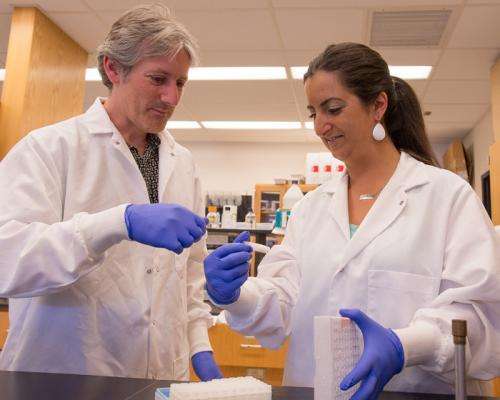Researchers develop a faster method to identify Salmonella strains

(Phys.org) —A method that promises to reduce by more than half the time it takes health officials to identify Salmonella strains has been developed by researchers in Penn State's College of Agricultural Sciences.
The finding is important because it promises to significantly speed up the response to many outbreaks of foodborne illness, allowing epidemiological investigators to "subtype" the exact strains of Salmonella that make people sick and to more quickly find—and eliminate—the source of the disease.
"There are more than a million estimated cases of salmonellosis annually in the United States, resulting in approximately 400 deaths, nearly 20,000 hospitalizations and an economic burden of millions of dollars," said study lead author Nikki Shariat, postdoctoral researcher in molecular microbiology in the Department of Food Science.
"Right now, public-health laboratories use a technique called pulse field gel electrophoresis, or PFGE, to subtype Salmonella strains, and it normally takes one to three days to identify a specific strain. The technique we devised often takes just one day."
Working in collaboration with Carol Sandt, a scientist with the Bureau of Laboratories, Division of Clinical Microbiology, in the Pennsylvania Department of Health, and Eija Trees, a microbiologist at the U.S. Centers for Disease Control and Prevention, Shariat was able to develop the new approach to identifying bacteria strains.
For the study, which was published online in May in the Journal of Clinical Microbiology, the state health department provided Penn State researchers with Salmonella samples to subtype.
"Compared to the current method being used nationally and internationally to subtype Salmonella, our approach is faster," Shariat said. "The significance of that is you need to trace the source of an outbreak as quickly as you can before you start insisting on restaurant and farm closures.
"It is important to pinpoint the source of the bacteria—the quicker you do that the quicker you can respond to the disease outbreak."
Working under the direction of Edward Dudley, associate professor and the Casida Development Professor of Food Science, Shariat developed the new approach, designated as CRISPR-MVLST, to identify strains of the Salmonella serotype Newport.
The method focuses on two virulence genes and two novel regions of Salmonella DNA called clustered regularly interspaced short palindromic repeats, or CRISPRs. The researchers devised a method of multi-virulence-locus sequence typing, or MVLST, that can detect strain-specific differences in the DNA at these four locations.
Newport is the third most common serological variant of Salmonella, Shariat pointed out, and the incidences of this serovar increased by 46 percent between 1999 and 2009. In 2009, Newport accounted for 9.3 percent of total salmonellosis cases.
"The significance of our work is not just that we can subtype Salmonella strains in half the time or less compared to the protocol that is used right now, but also our approach is very comparable in terms of the data—our method yields results that are accurate and similar to the PFGE method now widely used."
The researchers had an opportunity to test the accuracy of their CRISPR-MVLST method in an impromptu blind study. Toward the end of the research project, they applied their analysis to a Salmonella outbreak that occurred in Pennsylvania last summer associated with tomatoes, in which 37 people got sick.
"The Pennsylvania Department of Health sent us 20 isolates, 10 from the outbreak and 10 not from the outbreak, and we did the analysis not knowing which ones were which," Shariat explained. "We were able to identify exactly those that were associated with the outbreak."
The CRISPR-MVLST method also is likely to be much cheaper, she suggested. "Additionally, the DNA sequence is basically a text file that is very easy to communicate and share between laboratories nationally and internationally," Shariat said. "The data is definitely more robust."
Shariat explained that the new method is different from current methods of evaluating bacteria because it looks at the DNA sequence, whereas the other method basically cuts the DNA into small pieces with no actual sequence information.
"Fifty percent of bacteria have CRISPR regions, and using these for identification has been done with a quite a few bacteria, such as Mycobacterium tuberculosis, as well as with some that cause foodborne illness, such as Campylobacter and E. coli."
Journal information: Journal of Clinical Microbiology
Provided by Pennsylvania State University
















